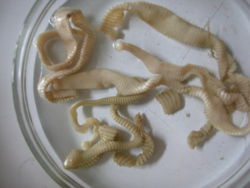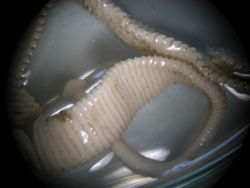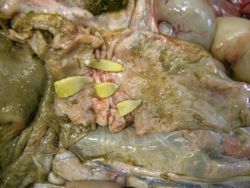Difference between revisions of "Tapeworm - Donkey"
m (Protected "Tapeworm - Donkey" [edit=sysop:move=sysop]) |
|||
| Line 1: | Line 1: | ||
{{review}} | {{review}} | ||
| + | |||
| + | [[Image:Tapeworm donkey.jpg|right|thumb|250px|<small><center>Tapeworm (Image courtesy of [http://drupal.thedonkeysanctuary.org.uk The Donkey Sanctuary])</center></small>]][[Image:Tapeworm 2 donkey.jpg|right|thumb|250px|<small><center>Tapeworm (Image courtesy of [http://drupal.thedonkeysanctuary.org.uk The Donkey Sanctuary])</center></small>]][[Image:Tapeworm 3 donkey.jpg|right|thumb|250px|<small><center>Tapeworm (Image courtesy of [http://drupal.thedonkeysanctuary.org.uk The Donkey Sanctuary])</center></small>]] | ||
| + | ==Introduction== | ||
| + | |||
| + | Tapeworms or cestodes belong to the group of parasites called flat worms or platyhelminths. ''Anoplocephala perfoliata, A. magna ''and ''Paranocephala mammilana'' are common species. Recent studies have shown that ''A. perfoliata'' is the most common equine tapeworm. | ||
| + | |||
| + | ==Diagnosis== | ||
| + | |||
| + | ===Clinical signs=== | ||
| + | |||
| + | Tapeworms have been incriminated as a cause of intestinal intussusceptions, caecal perforation leading to peritonitis, intestinal obstruction and colic. The severity and depth of ulcerative lesions of the mucosa increase as the number of tapeworms attached in the area increases (Williamson ''et al'', 1997). Although the pathogenic effect of tapeworm infection in donkeys has not been studied experimentally, similar lesions, particularly ulcerations of the ileocaecal junction, have been observed in donkeys. | ||
| + | |||
| + | ===Laboratory tests=== | ||
| + | |||
| + | Diagnosis using conventional '''faecal floatation''' methods has low sensitivity, due to uneven egg distribution in faeces. However, it is highly specific, as the tapeworm eggs are distinctively angular and readily identified. | ||
| + | |||
| + | '''Serological diagnosis''' with [[ELISA testing|enzyme-linked immunosorbent assay (ELISA)]] using excretory/secretory (E/S) antigens has been developed to detect the antibody in serum (Proudman and Trees, 1996). | ||
| + | |||
| + | At [http://drupal.thedonkeysanctuary.org.uk/ The Donkey Sanctuary] less than 1% of donkeys admitted have evidence of tapeworm infection on faecal examination. ''Post-mortem'' evidence suggests an even lower incidence. The low incidence may be due to the poor habitat for oribatid mites (the intermediate host for ''Anoplocephala'') on its farms. On the other hand, a study made in Ethiopia has shown a high prevalence of anoplocephalosis in donkeys, particularly in highland areas where permanent pasture management is often practised (Getachew ''et al'', 2006). | ||
| + | |||
| + | ==Treatment== | ||
| + | |||
| + | At [http://drupal.thedonkeysanctuary.org.uk/ The Donkey Sanctuary], treatment for tapeworm is only carried out when there is positive identification of eggs in the faeces and/or positive serology. | ||
| + | Treatment options include: | ||
| + | |||
| + | * [[Morantel|Pyrantel]] at twice the dose rate for roundworms. Donkeys at [http://drupal.thedonkeysanctuary.org.uk/ The Donkey Sanctuary] are checked for hepatic disease (blood parameters) prior to treatment, as dose rates at this level may be contra-indicated in donkeys with liver problems. | ||
| + | |||
| + | * [[Praziquantel]] is also effective against tapeworm in donkeys. | ||
| + | |||
| + | ==References== | ||
| + | |||
| + | * Trawford, A. and Getachew, M. (2008) Parasites In Svendsen, E.D., Duncan, J. and Hadrill, D. (2008) ''The Professional Handbook of the Donkey'', 4th edition, Whittet Books, Chapter 6 | ||
| + | * Getachew, M., Innocent, G., Trawford, A., Feseha, G., Reid, S.J.W., and Love, S. (2006). ‘Equine cestodosis: a sero-epidemiological study of ''Anoplocephala perfoliata'' infection in Ethiopia’. Proceedings of the 9th Congress of World Equine Veterinary Association. 22-26 January 2006. Marrakech, Morocco. | ||
| + | * Proudman, C.J., Trees, A.J. (1996). ‘Use of excretory/secretory antigens for the serodiagnosis of ''A. perfoliata'' cestodosis’. ''Vet. Parasitol.'' 61. pp 239-247. | ||
| + | * Williamson, R.M.C., Gasser, R.B., Middleton, D., and Beveridge, I. (1997). ‘The distribution of ''Anoplocephala perfoliata'' in the intestine of the horse and associated pathological changes’. ''Vet.Parasitol.'' 73. pp 225-241 | ||
Revision as of 12:33, 21 February 2010
| This article has been peer reviewed but is awaiting expert review. If you would like to help with this, please see more information about expert reviewing. |



Introduction
Tapeworms or cestodes belong to the group of parasites called flat worms or platyhelminths. Anoplocephala perfoliata, A. magna and Paranocephala mammilana are common species. Recent studies have shown that A. perfoliata is the most common equine tapeworm.
Diagnosis
Clinical signs
Tapeworms have been incriminated as a cause of intestinal intussusceptions, caecal perforation leading to peritonitis, intestinal obstruction and colic. The severity and depth of ulcerative lesions of the mucosa increase as the number of tapeworms attached in the area increases (Williamson et al, 1997). Although the pathogenic effect of tapeworm infection in donkeys has not been studied experimentally, similar lesions, particularly ulcerations of the ileocaecal junction, have been observed in donkeys.
Laboratory tests
Diagnosis using conventional faecal floatation methods has low sensitivity, due to uneven egg distribution in faeces. However, it is highly specific, as the tapeworm eggs are distinctively angular and readily identified.
Serological diagnosis with enzyme-linked immunosorbent assay (ELISA) using excretory/secretory (E/S) antigens has been developed to detect the antibody in serum (Proudman and Trees, 1996).
At The Donkey Sanctuary less than 1% of donkeys admitted have evidence of tapeworm infection on faecal examination. Post-mortem evidence suggests an even lower incidence. The low incidence may be due to the poor habitat for oribatid mites (the intermediate host for Anoplocephala) on its farms. On the other hand, a study made in Ethiopia has shown a high prevalence of anoplocephalosis in donkeys, particularly in highland areas where permanent pasture management is often practised (Getachew et al, 2006).
Treatment
At The Donkey Sanctuary, treatment for tapeworm is only carried out when there is positive identification of eggs in the faeces and/or positive serology. Treatment options include:
- Pyrantel at twice the dose rate for roundworms. Donkeys at The Donkey Sanctuary are checked for hepatic disease (blood parameters) prior to treatment, as dose rates at this level may be contra-indicated in donkeys with liver problems.
- Praziquantel is also effective against tapeworm in donkeys.
References
- Trawford, A. and Getachew, M. (2008) Parasites In Svendsen, E.D., Duncan, J. and Hadrill, D. (2008) The Professional Handbook of the Donkey, 4th edition, Whittet Books, Chapter 6
- Getachew, M., Innocent, G., Trawford, A., Feseha, G., Reid, S.J.W., and Love, S. (2006). ‘Equine cestodosis: a sero-epidemiological study of Anoplocephala perfoliata infection in Ethiopia’. Proceedings of the 9th Congress of World Equine Veterinary Association. 22-26 January 2006. Marrakech, Morocco.
- Proudman, C.J., Trees, A.J. (1996). ‘Use of excretory/secretory antigens for the serodiagnosis of A. perfoliata cestodosis’. Vet. Parasitol. 61. pp 239-247.
- Williamson, R.M.C., Gasser, R.B., Middleton, D., and Beveridge, I. (1997). ‘The distribution of Anoplocephala perfoliata in the intestine of the horse and associated pathological changes’. Vet.Parasitol. 73. pp 225-241
|
|